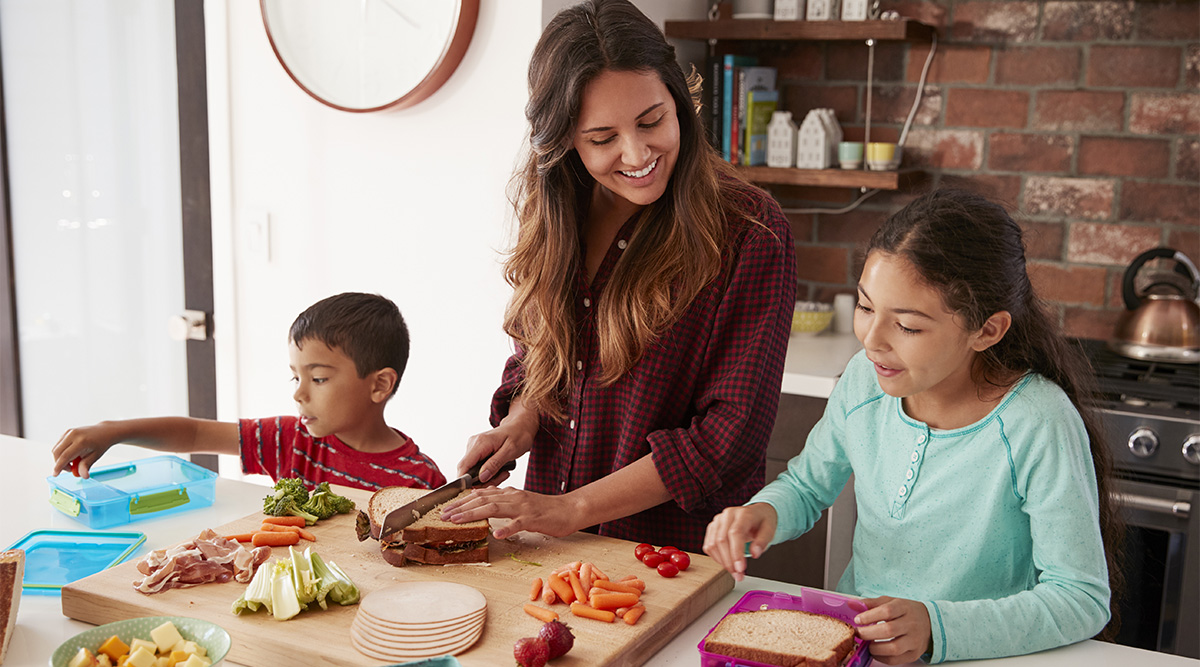
5 Tips and Tricks for Packing Healthier Lunches
IFT’s Anna Rosales shares secrets for serving up nutritious lunchtime eats for the younger set.

With summer winding down and schools mostly back in session, a dreaded task has crept back onto the to-do lists of parents everywhere: packing lunches. For tips on how to make that chore a little easier without sacrificing nutrition, we turned to IFT’s Senior Director of Government Affairs and Nutrition Anna Rosales (who is also a nutritionist and packer of lunches for her two children). On a typical school night, time and energy are in short supply, Rosales says. “I can’t spend 30 minutes packing a lunch—and it’s not going to look like a charcuterie board on Pinterest.” Read on to find out how she gets the job done quickly while consistently delivering healthful options that her kids will enjoy.
Tip 1: Get buy-in by getting kids involved
First and foremost, I want the kids to like their lunch. I want them to consume it. I don’t want it to be thrown in the garbage or come back home. Maybe that means cutting something into fun shapes (carrots look totally different when they’re round) or using a reusable bag with a cool print. Engage kids in the process of making or planning their lunch. Giving them that bit of autonomy goes a long way.
Tip 2: But hold the line on fruits and veggies
I push the dietary guidelines for fruits and vegetables, so you will have a fruit and/or a vegetable at every lunch and dinner. It’s non-negotiable. They can select which ones they want. Do they get to have something else? Yes. Maybe it’s a cookie or a snack, but fruits and vegetables first. Again, make it fun and easy: use little containers with space for cut-up veggies and a dip or pack a shelf-stable fruit cup. One trick is to integrate veggies with the main meal—add broccoli and garbanzos to pasta or top rice or quinoa with a fried egg, sautéed green beans, sesame seeds, and teriyaki sauce. Create a formula that works for your family. Ours is generally a veggie + starch + protein = lunch. There is no one-size-fits-all approach. Just focus on a meal pattern that’s right for you.
Tip 3: Pro move: pack lunch straight from the dinner table
I overcook at dinner so that we have leftovers for lunch. We do a lot with rice bowls. The bowls have lids that fit on top. I add more rice and veggies to the bowls, put the lids on them, and put them straight into the fridge. The next morning, we heat them up, transfer to a thermos, and off they go to school. Similarly, a roast chicken dinner becomes quick chicken sandwiches. It happens right after dinner when the food’s still on the table. I don’t put food away then pull it all back out later to make lunches. There’s no way that’s happening. Just remember to keep leftovers safe by following proper food handling practices.
Tip 4: It’s OK to lean on processed foods
A lot of times people hear “processed food” and are confused about their healthfulness. How a food is processed should not be the focus for dietary decisions. While you do want to avoid foods that are high in sugar, salt, and saturated fat, there’s a plethora of processed foods that don’t have an excess of those things. It’s about getting more nutrient-dense foods that meet individual dietary needs. If I'm short on leftovers or limited on time, I always keep some convenience processed foods on hand that I know the kids will eat: one-minute pasta bags, grain bags, frozen broccoli (that can be microwaved and steams up perfectly), a can of garbanzo beans, healthy frozen meals like burritos—just let them defrost on an ice pack in the lunchbox. Any foods that are going to get my kids to eat healthfully and are rich in fiber and vitamins are on the table.
Tip 5: Got a picky eater? Give them some grace
Some kids are averse to certain colors or textures. A kid often needs to have repeated exposure to a food they initially dislike. But I’m not a huge fan of forcing things in my child’s lunch. Yes, they need to have healthy foods, but food is so much more than nutrients. Nobody wants to open their lunch and be greeted with something that brings them dread. Lunchtime is a moment of pause that brings you joy and happiness. Stick to favorite items—if it’s smoothies they like, pack a store-bought smoothie (as your budget allows) and call it a day. There’s a time and a place for everything. Learn more about how to find foods your child will like and you can feel good about in Food Technology magazine.
Want to learn more about U.S. Dietary Guidelines and ways to promote adoption and adherence? IFT hosted a roundtable on the 2020-2025 Dietary Guidelines for Americans, which highlighted several different meal patterns that demonstrate the many ways to meet dietary needs. Read more about outcomes from the session here on the Brain Food Blog and in Journal of Food Science.
